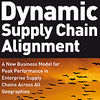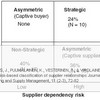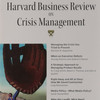 Dynamic Supply Chain Alignment. That is the magic formula that runs like a red thread through John Gattorna‘s latest book, where he demonstrates how there are four types of supply chains, based on four types of customer behavior. This is a well-written and excellently illustrated book, which I will take a closer look at, chapter by chapter, in order to answer the question: Is Dynamic Supply Chain Alignment the ultimate formula for streamlining your supply chain for the utmost performance?
Dynamic Supply Chain Alignment. That is the magic formula that runs like a red thread through John Gattorna‘s latest book, where he demonstrates how there are four types of supply chains, based on four types of customer behavior. This is a well-written and excellently illustrated book, which I will take a closer look at, chapter by chapter, in order to answer the question: Is Dynamic Supply Chain Alignment the ultimate formula for streamlining your supply chain for the utmost performance?
John Gattorna and friends
The book contains 28 chapters, written by John Gattorna and friends, so the cover says. Eight of the chapters are written or co-written by John Gattorna himself. The others are written by individual authors, selected from both the industry and academia, which makes this book a perfect choice and valuable to both the professional, the practitioner and the researcher. It provides a number of case studies and theoretical discussions on the virtues of customer segmentation, and much of the book’s value stems from a short ‘alignment insights’ summary at the end of each chapter, highlighting the main issues of each chapter. A major plus of this book are the clear figures, all held in (more or less) the same style. Normally, with different authors, the figures and diagrams would be in different styles, but not here. That is why this book appears incredibly structured and cohesive from the first to the last page.
Living Supply Chains
 Dynamic Supply Chain Alignment picks up the notions presented in a previous book by John Gattorna, Living Supply Chains, where the four supply chain types are presented in-depth: Continuous Replenishment, Lean, Agile, Fully Flexible. Dynamic Supply Chain Alignment takes Living Supply Chains one step further. The key issue is to not make your supply chain one type only, but to keep it open-ended, such that the appropriate supply chain constellation can be matched to the according customer or supplier or product.
Dynamic Supply Chain Alignment picks up the notions presented in a previous book by John Gattorna, Living Supply Chains, where the four supply chain types are presented in-depth: Continuous Replenishment, Lean, Agile, Fully Flexible. Dynamic Supply Chain Alignment takes Living Supply Chains one step further. The key issue is to not make your supply chain one type only, but to keep it open-ended, such that the appropriate supply chain constellation can be matched to the according customer or supplier or product.
Customer Segmentation
![]() One downside that should be mentioned is a slight lack of explanation or legend as to the customer segmentation diagrams. Each type of supply chain is established to meet a certain type of customer behaviour. These behaviors are illustrated using circles and crosshairs marking the dominant parameter of the behavior, indicated by a letter: D, P A, I and a. Unfortunately, the letter combinations and quadrant segmentation (why is ‘P’ = ‘innovative’ and why in the upper right?) are not explained at all in this book, but in the previous Living Supply Chains. That is a major drawback of this book, since the segmentation circles pervade almost every figure in the book, and without an explanation, the uninitiated reader will soon run into problems and perhaps even discard this excellent book…
One downside that should be mentioned is a slight lack of explanation or legend as to the customer segmentation diagrams. Each type of supply chain is established to meet a certain type of customer behaviour. These behaviors are illustrated using circles and crosshairs marking the dominant parameter of the behavior, indicated by a letter: D, P A, I and a. Unfortunately, the letter combinations and quadrant segmentation (why is ‘P’ = ‘innovative’ and why in the upper right?) are not explained at all in this book, but in the previous Living Supply Chains. That is a major drawback of this book, since the segmentation circles pervade almost every figure in the book, and without an explanation, the uninitiated reader will soon run into problems and perhaps even discard this excellent book…
Not a textbook, but…
It is not a textbook that one reads from beginning to end, rather are the chapters like separate and closed episodes. That is what makes this book a fascinating read. Yes, they do complement and support each other, but they are also very different from each other. While some of the chapters do an excellent job in applying Gattorna’s alignment model and supply chain configurations, other chapters appear to be struggling with the concept and – at best – cursory mention how important alignment is. That said, all chapters are well-founded and well worth reading.
Chapter by chapter
Below is a brief chapter by chapter review/summary. A link to the author’s homepage (or other web page with author information) has been included wherever possible. If you believe there are better links, please don’t hesitate to contact me with a correction.
Prelude
John Gattorna and Anna Game Lopata
The prelude is a 43-page ‘summary of the discussions that took place during the 2008 Supply Chain Business Forum at Victoria University in Melbourne, Australia. Personally, I think it is an unnecessary prelude, especially considering that the discussions have already been published as a series of articles in Logistics magazine in Australia.
People powering enterprise supply chains
This chapter is a great starting point, explaining how people are at the center of all supply chains and that the key to successful supply chain execution is people. And, without much ado, John Gattorno dives straight into the four types of supply chains:
- Contimuous Replenishment Supply Chains
- Where relationships matter most
- Lean Supply Chains
- Where the focus is on efficiency and lowest cost-to-serve
- Agile Supply Chains
- Where Quick response is paramount
- Fully Flexible Supply Chains
- Where nothing is impossible
Interestingly, at the end of the chapter he follows up with advocating biased key performance indicators instead of balanced scorecards, thus replacing the old school one-size-fits-all supply chain.
Requisite collaboration in enterprise supply chains
Gattorna contends that collaboration is an overused and overworked concept and that it is not advisable to implement it in any other supply chains besides the continuous replenishment supply chain. Furthermore, collaboration makes sense only with those who truly want to collaborate. There and only there is where collaboration can add value to the supply chain, and requisite collaboration means to adjust the level of collaboration accordingly.
Building relationships that create value
Richard Wilding and Andrew Humphries
This chapter deals with the management, or rather, the measurement of supply chain relationships. While collaboration can add to supply chain performance, it is equally important to to understand and measure the collaboration efforts. Thus, the authors introduce the Supply Chain Collaborating Index (SCCI), a method of analyzing and diagnosing collaborative business relationships:
- Key performance drivers:
- Creativity, Stability, Communication, Reliability, Value
- Relationship characteristics:
- Long-term orientation, Interdependence, Collaboration, Trust, Commitment, Adaptation, Personal relationships
Key message: If you cannot measure it, you cannot improve it.
Lean and agile supply chains
This is the shortest chapter in the book, a mere 4 pages. No surprise, actually, because Gattorna is by no means a champion of the lean supply chain philosophy, quite the contrary. Gattorna strongly suggest that lean should only be applied where lean is absolutely appropriate, and he implies that more often than not, lean is not the appropriate strategy.
Fully flexible supply chains are formed in response to (extreme) business events, but not only that. Fully flexible supply chains are also what is needed in response to an emergency or humanitarian crisis. In fact, humanitarian supply chains are not fully flexible from the start, they evolve and go through all the supply chain categories during the 4 phases of their life cycle:
- Lean + Collaborative (Prequel)
- Stockpiling goods
- Agile (Phase 1)
- Executing quick response
- Fully Flexible (Phase 2)
- ‘Improvising’ creative solutions on site
- Collaborative + Lean + Agile (Phase 3)
- Developing systematic/structured activities
- Returning to ‘normal’
Humanitarian supply chains are ‘extreme’ supply chains with a high level of uncertainty in constantly changing environments. Traditional supply chains may often hinder (rather an facilitate) the response efforts.
The humanitarian context differs considerably from the commercial context, and humanitarian supply chains must deal with perhaps the most challenging requirements of all: They must be multiple, global, dynamic and temporary. While the ability to rapidly respond and adapt is the strong side, humanitarian supply chains also have a weak side: Because of their temporal nature, there is seldom any long-term performance measurement (and thus improvement).
- Lack of recognition of the importance of logistics
- Lack of professional staff, particular on site
- Ineffective leveraging of technology
- Lack of institutional learning
- Limited collaboration among humanitarian organizations
In my opinion this is a rather harsh verdict on humanitarian supply chains, but importantly, it provides some ground for the improvement and alignment of humanitarian supply chains.
This chapter points out that in disaster response, military supply chains can play a major role side-by-side with humanitarian supply chains. However, roles and responsibilities need to be clearly separated, because the military community has different objectives, schedules and priorities from the humanitarian community. In order to separate roles and responsibilities while preserving the internal alignment of both supply chains there must be coordination, but not collaboration. Military operations may enable access for humanitarian operations, but neither party should be part of the other party’s operations.
Revisiting and refining Lee’s ”Triple-A supply chain”
I’ve read Lee’s article on the Triple-A Supply Chain, and I liked it very much. What Gattorna does, is to take a critical look at Lee’s three A’s: Adaptability, Agility and Alignment, and place them within his own vernacular of supply chain categories. Here, Agility becomes just one of many supply chain configurations, Adaptability becomes the ability to flex in the extreme when disruptions occur, and Alignment becomes the ability to engage different supply chain configurations according to customer buying behavior. Most important though is to understand that the internal culture more than external structure plays the biggest role in improving supply chain performance.
Designing supply chain organizations for peak-performance
Another fitting title for this chapter could be ‘From silos to daisies’, because here Gattorna shows that in traditional supply chains the company itself, and not the customer is the focus of supply chain organization. Instead of setting up a supply chain along the traditional silos, supply chains should use cross-organizational and customer-centric clusters, similar to a daisy. Ideally, the clusters will differ from supply chain configuration to supply chain configuration, which in itself differs from customer segment to customer segment.
The supply-side view and reverse logistics
John Gattorna and Deborah Ellis
Supply chains are generally seen as having a forward movement, where ‘reverse logistics’ refers to the return of a (defect) product. These days, reverse logistics is a lot more, and includes activities such as avoiding return and recycling of products at the end of their life cycle. Interestingly, the same supply chain configurations as for the foward supply chain can be used for the reverse supply chain:
- The Agile Return Path
- Where time is the key driver
- The Lean Return Path
- Where cost is the key driver
- The Continuous Replenishment Supply Chain
- Where relationships are the key driver
- The Fully Flexible Return Path
- Where it’s all about risk (and recall)
Basically, effective return and recycling operations demand the same clear paths and processes as forward supply chains.
Sales and operations planning – the critical ingredients in supply chain operations
This chapter applies the principles of sales and operations planning to each of the four supply chain configurations. In particular, the continuous replenishment supply chain and lean supply chain configurations can benefit greatly from the sales and operations planning framework, because it balances and integrates decision-making across functions and organizations. Consequently, it also works in agile supply chains, and surprisingly also in fully flexible supply chains, despite the fact that the notion of uncertainty inherent in fully flexible supply chains runs counter to the notion of predictability that is inherent to sales and operations planning. Nonetheless, sales and operations planning can provide pre-calculated and contingent decision variables that can be used to address the impacts of sudden events in the supply chain.
Supply chain integration layer
A better title for this chapter would be ‘Supply Chain Visibility’, for that is what this chapter is all about. In simple terms, supply chain visibility is a system for identifying the identity, location and status of entities transiting the supply chain, captured in timely messages about events, along with the planned and actual times for these events. Supply Chain Visibility can be achieved by applied what is known as Business Activity Monitoring, which must be couched in the widest possible context in order to include more than just the physical movement of goods.
Supply chain configurations and the impact of different pricing strategies
This chapter addresses how to develop a coherent pricing approach that is aligned with the four supply chain configurations. Customer segmentation provides the foundation for developing a company’s pricing and service offer structures. Properly aligning price and service offers to a customer’s worth, needs and other characteristics provides many opportunities for companies to create new value for their business.
Performance measurement – shaping supply chain sub-cultures
This chapter explores the role of performance management and how each supply chain configuration will have its own performance measures:
- Continuous Replenishment Supply Chains
- Service reliability and quality
- Lean Supply Chains
- Service reliability and price
- Agile Supply chains
- Speed of response
- Fully Flexible Supply Chains
- Speed and appropriateness of contingent response
Using network optimization modeling techniques to resolve supply chain complexity and achieve aligned operations
This chapter discusses the most common decision support tool used to support strategic and tactical supply chain network design decisions – the network optimization model.
DHL Taiwan – aligning the express business with customers
This chapter delivers an in-depth discussion of the four types of customer behavior and how DHL Taiwan aligned their supply chain accordingly, improved their supply chain performance, and experienced between 8 and 16 percent increase in customer retention.
Aligning Fonterra’s global supply chain network
This chapter shows how the New Zealand dairy company Fonterra used customer segmentation to focus their resources and efforts. Particular emphasis is given to the collaborative segment.
Supply chain alignment – Brazilian style
Carlos Frederico Bremer, Rodrigo Cambiaghi Azevedo, Carlos Aravechia and Lucas Cley da Horta
This chapter contains two case studies from Brazil and illustrates the re-engineering of supply chain management practices in line with the principles of customer segmentation and dynamic supply chain alignment.
Supply chain alignment – European style
This chapter seeks to provide insights into the realities of applying dynamic supply chain alignment in Europe, a politically and geographically diverse continent and thus challenging environment for any supply chain configuration. Using the principles of dynamic supply chain alignment it is possible to discern four types of alignment: Strategic alignment, Customer alignment, Internal alignment and Supplier alignment.
Corporate social responsibility in enterprise supply chains
Mark Reynolds and Leeora Black
This is one of the chapters that struggles ever so slightly with applying dynamic supply chain alignment to the chapter topic. While the chapter insights mention that large-scale sustainable outcomes can only be achieved with the help of finely tuned and aligned supply chains that connect together all all the activities through the life cycle of products, there is very little in the chapter to exemplify or elaborate further how this can be done.
Building sustainable supply chains for the future
This chapter does a much better job than the preceding in applying dynamic supply chain alignment to develop sustainable supply chains, and also uses the SCOR model (Plan – Source -Make – Deliver – Return – Dispose) to show where alignment can be achieved along each phase of the supply chain.
Managing disruptions in contemporary supply chains
Kevin B. Hendricks and Vinod R.Singhal
This chapter highlights that while there are four generic types of supply chain configurations, there are potentially a lot more than four generic types of supply chain disruptions. Risk is dynamic, and managers make choices, choices that ultimately will effect the outcomes of disruptions. What makes risk management even more difficult is that the risk preferences of the various stakeholders (owners, customers, suppliers, partners, etc.) may run contradictory to the principles of the current supply chain configuration, i.e. a demand for increased efficiency may improve performance, but it may also increase the impact of disruptions, should they occur.
The coming of age of third party logistics providers
Jeremy Clarke and John Gattorna
As supply chains evolve and become ever more global and complex and intertwined, third-party logistics providers (3PL) will become ever more important. These 3PL must be able to tailor their services to the various supply chain configurations and adapt existing contracts to sudden changes in the existing configuration. All in all, 3PL appears to be better suited for surviving the future challenges than 4PL. What is most important is how the 3PL level manages or aligns with the two lower levels.
Tax-aligned supply chains
Brett Campbell and Alyson Rodi
This is an interesting supply chain configuration: the tax-aligned supply chain (TASC). The idea behind this concept is that supply chain decisions have tax implications, and tax implications affect the financial performance of supply chains. TASC is right if an organization
- has significant supply chain operations in several countries
- is undergoing significant changes (e.g. mergers and restructuring)
- is pursuing aggressive cost-reduction goals
- is planning new manufacturing, distribution or R&D facilities
- is adopting a new supply chain infrastructure
Thus, the key is take advantage of tax-saving opportunities, that should not come as a short-term bonus or sudden windfall when they are (accidentally) discovered, but that should be part of a long-term strategy of improving after-tax returns.
The emergence of national logistics cities
Pieter Nagel, Michael Proffitt, Keith Toh and Roger Oakden
What is a National Logistics City? Singapore is perhaps the prime example of a planned development around a nucleus freight terminal that turns into a freight hub because there is sufficient provision of appropriate infrastructure and physical facilities (road, rail, sea and air), connected by IT and supported by logistical services such as warehousing, distribution and forwarding services. It goes without saying that this can only be achieved by aligning supply chains and by aligning industry with government and city development. Other cites are in the making and the chapter tells you which.
The importance of intellectual capital and knowledge in the design and operation of enterprise supply chains
This chapter aligns knowledge management with the four supply chain configurations, showing that each configuration demands a different approach and focus when it comes to retaining and using knowledge.
- Lean Supply Chains
- The Factory – Rock-solid core business
- Continuous Replenishment Supply Chains
- The Cafe – Relationships matter most
- Agile Supply Chains
- The Triage – Quick response is paramount
- Fully Flexible Supply Chains
- The Test Lab – Achieving the impossible
The metaphors for describing the knowledge focus in each configuration are very interesting indeed.
China and India – future giants of supply chain developments in the twenty-first century
This chapter focuses on China as the new manufacturing powerhouse of supply chains and India as the new technology powerhouse of supply chains. Combined and aligned, this will advance and enhance the development of supply chains in the Asian region. Personally I think they forgot to mention Indonesia here, since ‘Chindonesia’ (or perhaps ‘Chindapore’?) is curently seen as the strongest emerging market in the region.
The supply chains of 2030
John Gattorna and Deborah Ellis
The final chapter makes the case that the supply chain of the future needs to break away from the conventions of the past and needs to find new business models (and supply chain configurations, of course). Supply chains are set to become the center of a business’ health and well being, rather than simply a specialist function. Supply chains are the business, not simply a part of the business. With this philosophy, supply chains must not only be aligned internally and enterprise-wide, but also externally with each and every stakeholder. And many businesses currently not seeing themselves as a supply chain will have to re-think their strategies and start applying dynamic supply chain alignment. If that comes true, and that is my personal opinion here, supply chain management as a workplace will have a bright future, well beyond the operational logistics it once was meant to cover.
Conclusion
Dynamic Supply Chain Alignment is an excellent book, although clearly more geared towards practice than towards research. From a supply chain risk perspective, the main focus of this blog, only one chapter is worth reading. Nonetheless, from an overall and holistic supply chain perspective it is one of the very best books I have read. My recommendation though would be to read (or at least browse through) Living Supply Chains first, and then Dynamic Supply Chain Alignment. While Dynamic Supply Chain Alignment can stand perfectly well on it’s own it is best enjoyed together with Living Supply Chains.
What are the industry thoughts on Dynamic Supply Chain Alignment?
To answer this question I initiated a question on LinkedIn:
In his book Dynamic Supply Chain Alignment, John Gattorna narrows the world of supply chains down to 4 supply chain configurations, based on four types of customer behavior: Continuous Replenishment, Lean, Agile, Fully Flexible. While I am fascinated by the Gattorna’s ideas, I am wondering, is this a widely used concept or not?
Here is what people said about Dynamic Supply Chain Alignment on LinkedIn
Reference
Gattorna, J (2009) Dynamic Supply Chain Alignment. A new Business Model for Peak Performance in Enterprise Supply Chains Across All Geographies. Farnham: Gower Publishing.
Gattorna, J (2006) Living Supply Chains. How to mobilize the enterprise around delivering what your customers want. Harlow: Pearson Education.
Publisher link
- Gower Publishing: Dynamic Supply Chain Alignment
Related
- husdal.com: Lean + Agile = Leagile: A happy marriage?











